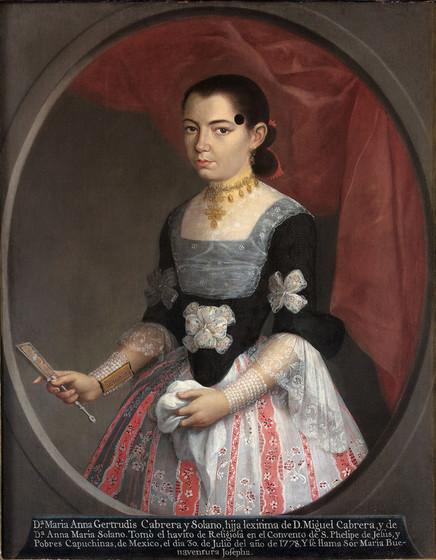Walking through the exhibition Painted in Mexico, 1700–1790: Pinxit Mexici, visitors frequently ask about the black spots on the temples of several women. These spots are not mistakes or patches in the paintings, but actually beauty marks! Known as chiqueadores, these artificial marks were made from tortoiseshell or fabric—such as silk or velvet—and applied to the wearer’s head. This international fad can be seen in 18th-century portraits from across Europe and the Americas. In Europe, the patches were first used to cover scars and blemishes and later their placement became a flirtatious symbol that conveyed the wearer’s availability and desires. In Mexico, women typically wore their chiqueadores on their temples, suggesting that their origin may be related to traditional headache cures, with medicinal herbs placed under the patch. In the exquisite example of Juan Patricio Morlete Ruiz’s Portrait of Doña María Tomasa Durán de López de Cárdenas, the large patch is refined into delicate sun and moon shapes.
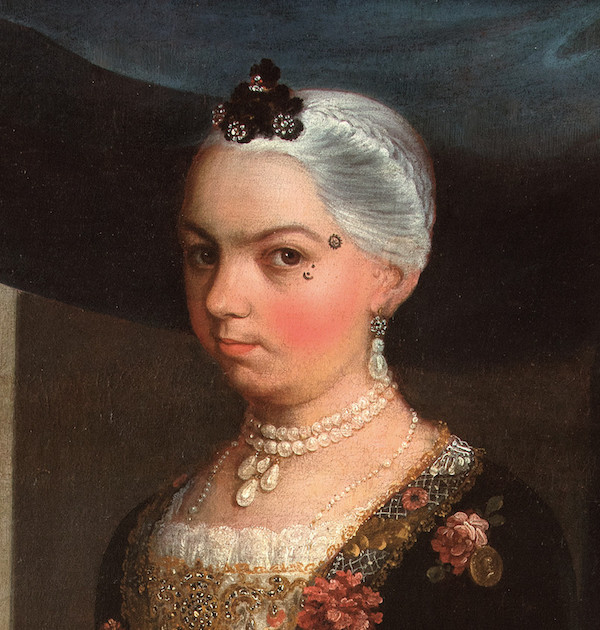
While it was typical for Mexican women to wear just one chiqueador, there are known instances of women wearing many more. For example, in a portrait of Doña María de la Luz Padilla y Gómez de Cervantes painted by Miguel Cabrera (famed painter and father of María Ana Gertrudis Cabrera y Solano, pictured above) in the collection of the Brooklyn Museum, the sitter wears no less than five beauty marks around her eyes and chin!
Portraiture experienced a surge in 18th-century Mexico, corresponding to increasing wealth and economic growth. Portraits became a way for the rising elite to preserve their memory and present themselves to society, with their clothes and accessories carrying specific meanings.
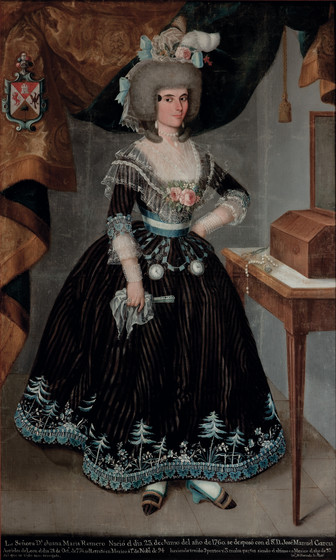
Doña Juana María Romero, the wife of a farmer, came into money following the death of her godfather, a priest. The portrait by Ignacio María Barreda, likely painted to celebrate her surviving 13 pregnancies, shows off Doña Juana María’s new wealth and her awareness of international trends. Her chiqueador peeks out from behind her powdered coiffure—frizzed, curled, and reminiscent of the styles made fashionable by the French queen Marie Antoinette. Her elaborate headdress—brimming with flowers and feathers, ribbons and lace—crowns her outfit with an undeniable sense of abundance, echoed by the two watches hanging from her waist and the strings of pearls wrapped around her wrists, both fashionable symbols of opulence. The cut string of pearls falling onto the floor suggests her excess, that she is so wealthy a few missing pearls won’t matter.
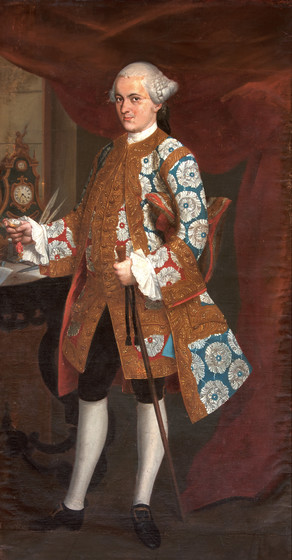
The men of New Spain were equally invested in the fashions of the day. This gentleman’s attire displays the international influences on Mexican clothing. His three-piece suit reflects the modern attire worn in Europe, enhanced by his exaggerated coattails. The textile, a richly decorated silk brocade, points to trade with Asia, from where many goods made their way to New Spain. The pattern is reminiscent of chrysanthemums and suggests a Japanese source. However, the contrasting red cuffs of his jacket point to a decidedly New Spanish taste. As scholar James Middleton has observed, while a jacket’s cuffs commonly matched its wearer’s waistcoat, in Europe rarely were two boldly patterned fabrics used together. In Mexico, on the other hand, pairing textiles with vibrant patterns was frequent, demonstrating a local interest in such exuberant juxtapositions. The man’s ruffled cuffs are an extension of his undergarments which, unlike his luxurious coats, were easily washed. These details point not only to the sitter’s fashion sense but also to his cleanliness.
While these portraits captured the finest clothes of the wealthy elite, the genre of casta (caste) painting allows us to learn more about the fashions of other socioracial groups. Casta paintings depicted the various processes of racial mixing between Spaniards, Africans, and indigenous Mexicans by showing family groups of parents and children.
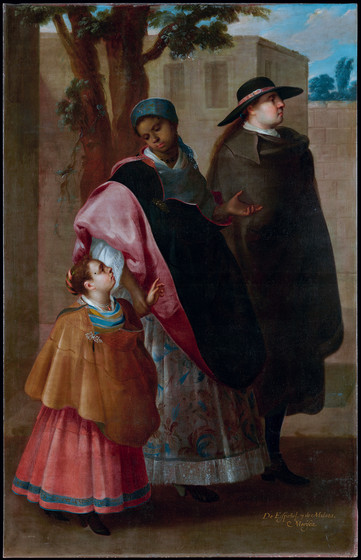
From Spaniard and Mulatta, Morisca, attributed to José de Ibarra (himself of Spanish and African descent), depicts the distinctive style of clothing that developed in response to the sumptuary laws that attempted to regulate dress. The painting’s title identifies the socioracial types pictured, a Spanish father, a mulatto mother (a woman of Spanish and African descent), and their “morisca” daughter. The mother and daughter both wear overblouses constructed like skirts draped over their shoulders. Identified by a contemporary traveler as sayas de embrocar (inverted skirts), these garments were typically worn by Mexican women of African descent who were prohibited from wearing Spanish-style clothing. However, the rich fabrics, the silver and gold brooches used as clasps, and the colorful and metallic ribbons used as adornments often resulted in an extravagant display, precisely one of the qualities the sumptuary laws aimed to prevent. The floral pattern of the mother’s skirt is likely a printed cotton chintz, similar to those that originated in India and circulated through China and Europe. The latest styles also reached across generations: the young daughter dons high heels and a small chiqueador, demonstrating that one is never too young for fashion!
Visit Painted in Mexico, 1700–1790: Pinxit Mexici until March 18 to see these styles and more, or join me for a tour on March 1 as we continue to delve into questions of fashion and beauty in 18th-century Mexico. For more on these paintings, read the catalogue entries by the exhibition co-curators in Painted in Mexico, 1700–1790: Pinxit Mexici, available in the LACMA Store.
Further Reading:
Katzew, Ilona, ed. Painted in Mexico, 1700–1790: Pinxit Mexici. Exh. cat. Los Angeles: Los Angeles County Museum of Art; Mexico City: Fomento Cultural Banamex, A.C.; Munich, London, and New York: DelMonico Books-Prestel, 2017. Cat. nos. 57, 80–83.
Middleton, James. “Reading Dress in New Spanish Portraiture: Clothing the Mexican Elite, circa 1695–1805.” In New England/New Spain: Portraiture in the Colonial Americas, 1492–1850, edited by Donna Pierce, 101–146. Denver: Denver Art Museum, 2016.



